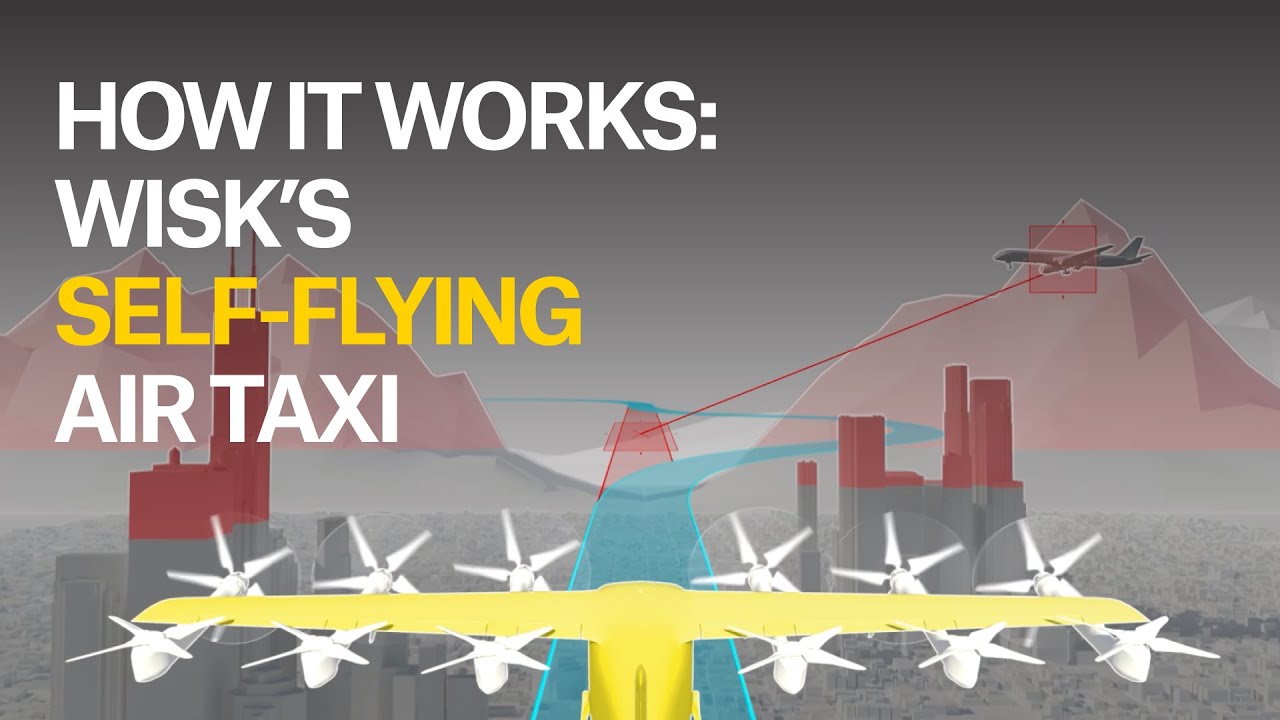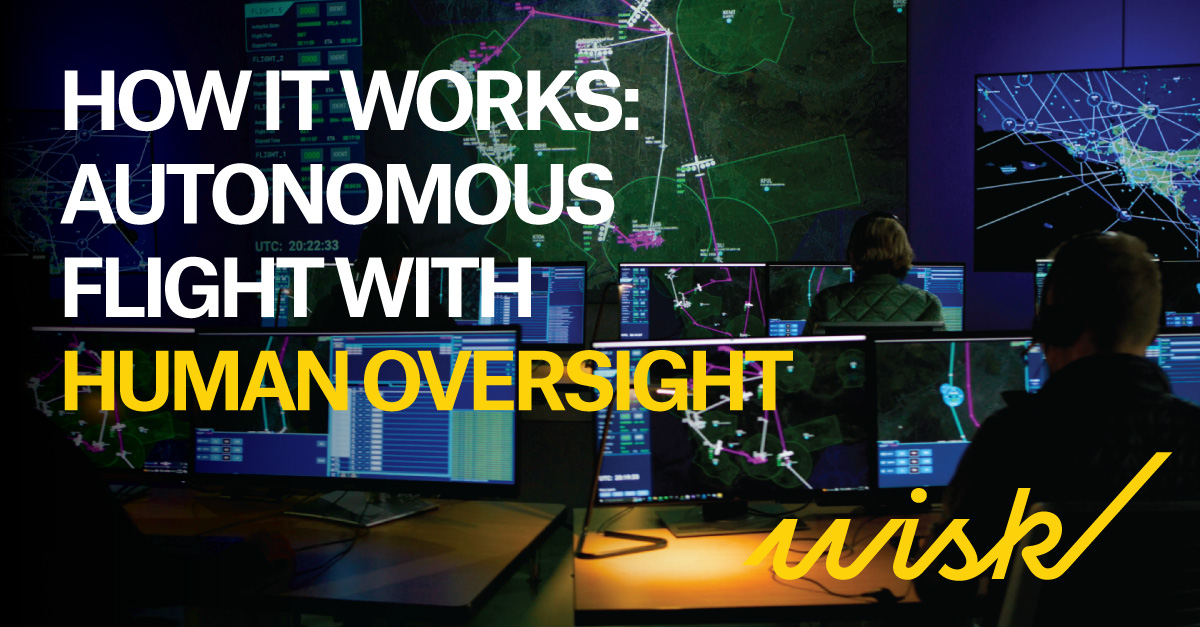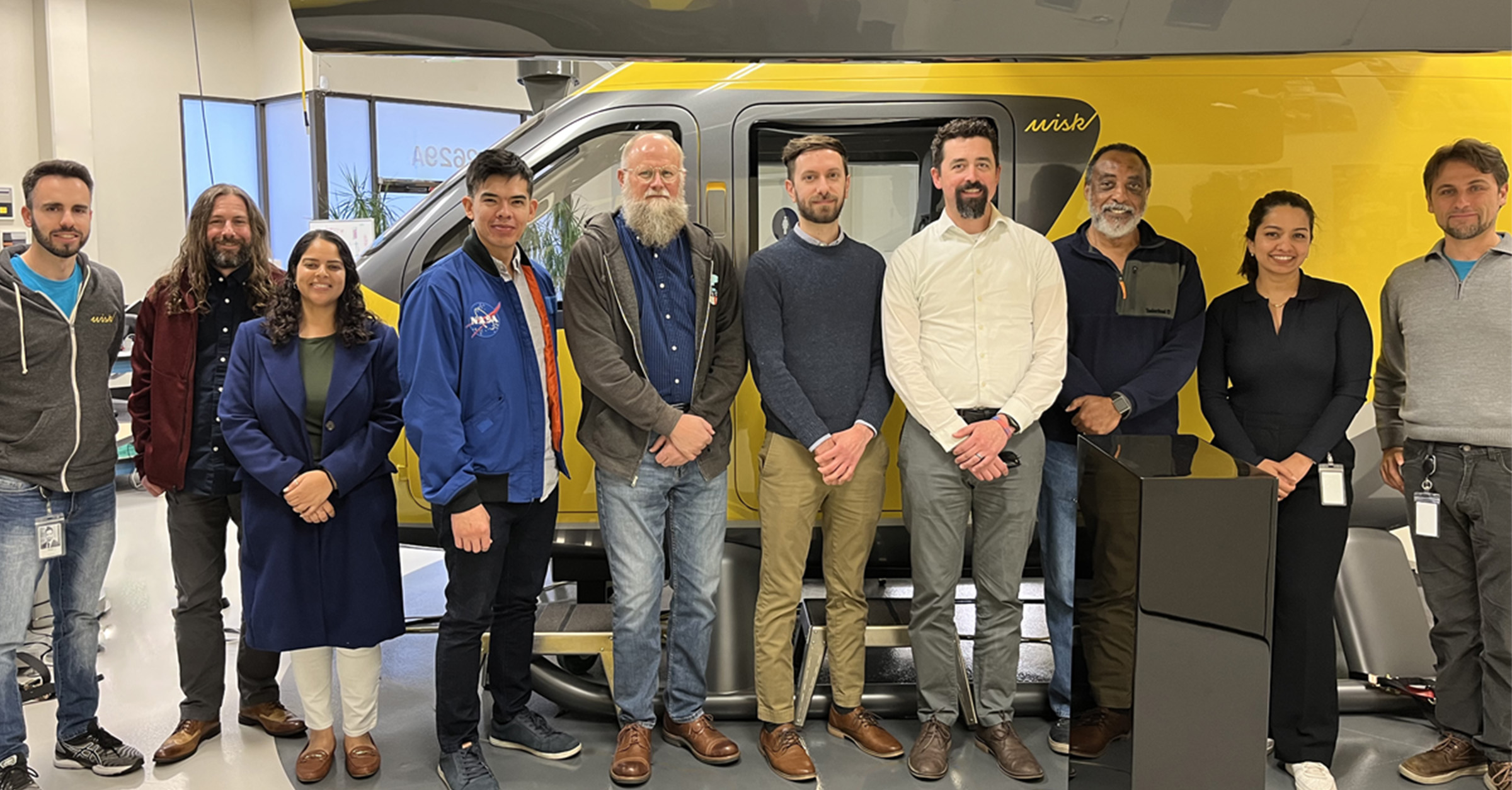At Wisk, we are focused on certifying the first four-passenger, autonomous, electric air taxi for commercial operations in the U.S. We believe that only through autonomy can the Advanced Air Mobility industry achieve the increased levels of safety, scalability, and affordability to ensure safe everyday flight for everyone.
Our self-flying approach means that there is no pilot on board the aircraft. In some ways, this is a paradigm shift but, in many ways, this is a natural evolution of today’s standard operating procedures in commercial aviation.
For example, ~93% of functions on a commercial airliner are performed by a computer. At Wisk, we’re taking that a step further. We start with the same proven, existing technologies, like autopilots, navigation systems, and flight management systems, that enable today’s commercial flights. Then we add proprietary, hierarchical, decision-making logic and algorithms, along with additional sensing capabilities, to create an even more automated system with predictable, deterministic outcomes.
By making the aircraft and its autonomous systems responsible for high-frequency and time-sensitive tasks, we free up the human to focus on the more complex, low-frequency tasks.

Learn more about how our autonomous system works.
Introducing the Multivehicle Supervisor
While there is no pilot onboard, we are not removing humans from the equation. Each of our flights will be initiated and monitored by a Multi-vehicle Supervisor (MVSor) from our Fleet Operations Center (FOC). The MVSor will supervise multiple Wisk air taxis at once and they are responsible for coordinating with air traffic control (ATC). The MVSor works closely with the broader Fleet Operations team (Fleet Managers, Hospitality Managers, and Ground Crew) to ensure that flights are safe and on time.
In the event it is needed, the MVSor can send new commands to the aircraft; however, they cannot take direct control of the aircraft and fly it remotely (there is no “stick and rudder pedals” in the system).
The aircraft and its autonomous system are designed to respond to most events – such as keeping clear of other air traffic and responding to system failures. However, the MVSor does have the capability to send commands to the aircraft (which the aircraft then executes autonomously), such as redirecting to an alternate landing site if the original landing site is unavailable, or redirecting the aircraft in response to ATC commands. The MVSor also has the ability to command the aircraft to initiate an immediate precautionary landing, if needed.

Learn more about the role humans play in our autonomous operations.
Creating a New Role in Aviation
Much like our autonomous system builds on today’s proven, existing technology, the MVSor role is an evolution of today’s human pilot role.
For example, every commercial passenger flight today is operated by two human pilots (potentially more, depending on the length of the flight). That wasn’t always the case. Previously, there were much larger crews in the front of the airplane, such as navigators and flight engineers. As technology evolved, those functions were able to be managed by computer, allowing those humans to take on pilot roles and the expansion of the industry. Similarly, our MVSor role is another evolution of the role humans can play within aviation.
However, it is important to clarify that we are not proposing to replace pilots on commercial airliners (with fully autonomous systems) or to eliminate pilot jobs. Instead, we are introducing an entirely new role in aviation. One that will create jobs – not take away – in a sector of aviation that doesn’t yet exist today. Additionally, these new jobs will be open to a wider pool of candidates than today’s aviation landscape.
Our mission to ensure that our aircraft and services are accessible to everyone doesn’t extend only to our passengers. Through this new role, we’re opening up opportunities for those who have traditionally not been able to secure a role in aviation for varying reasons, such as medical certification requirements.
For example, an individual in a wheelchair would not qualify to be a pilot on a commercial airliner. Through our MVSor role, they now have access to aviation jobs that they previously could not fill.
Testing
While this new role in aviation will be accessible to more people than traditional pilot roles, it doesn’t mean that just anyone can become a MVSor. But what specific skill sets, qualifications, or certifications will be required to become an MVSor?
We are working closely with the FAA and NASA to conduct in-depth testing to find the answer to this question. We’re looking closely at several areas, such as human factors and human-machine interactions to start.
According to the FAA, Human factors is a “multidisciplinary effort to generate and compile information about human capabilities and limitations and apply that information to equipment, systems, facilities, procedures, jobs, environments, training, staffing, and personnel management for safe, comfortable, and effective human performance” (FAA Order 9550.8A).
Human factors are well understood for the roles that humans play in aviation today – from pilots to aircraft mechanics to air traffic control. It is important that we work toward a similar understanding for the MVSor role as well. That’s why, as part of our testing, we’re looking at a multitude of factors that can impact performance.

Learn more about our human factors testing.
Over the past several months, we have conducted testing of our MVSor user interface, using both pilots and non-pilots. The goal of this testing is to understand both human factors and identity efficiencies that can be made in the autonomous system to improve the performance of the MVSor and, ultimately the safety of our operations. It is our hope that these learnings will filter out to the broader aviation industry.
An area that is critical to understanding human performance is human-machine interaction. This is important as we design the system and interface to support multi-vehicle supervision that ensures safe and efficient operations. This also allows us to understand the dynamic and workload for individuals who are managing multiple aircraft at once and identify areas where automation can help reduce workloads and further improve safety.
For example, in our most recent round of testing, we looked at how MVSors handle flight plan deviations issued by ATC. The purpose of the testing was to understand how an MVSor managing multiple aircraft responds to and handles multiple ATC commands. The testing provided valuable data and anecdotal feedback that help us evaluate and provide recommendations to the FAA for both the role of the MVSor and their interaction with the autonomous system, as well as improve the design of our system.
While we can’t share the specifics of our findings today, we can share that after each round of testing, we made adjustments to the user interface and processes to simulate various scenarios and approaches to answering our broader list of questions. Some approaches provided significant levels of improvement in performance, whereas others showed only moderate improvement.
Our hope is that the answers we find through our testing will result in broader safety improvements across aviation.
Conclusion
Creating an entirely new role in aviation presents both challenges and opportunities. While the task is not easy, the potential benefits to the broader aviation industry are worth the effort required. As we continue developing our MVSor role, we will need to answer questions that have never been asked before. For example, what type of qualifications will an MVSor need? Are they a commercial pilot or are they an Air Traffic Controller or both? Etc.
However, finding the answers to questions like these is both the exciting and challenging part of doing something that has never been done before. And, it can only be done in partnership with key stakeholders, such as NASA and the FAA. We will provide suggested requirements for this role to the FAA – they will then provide final approval of the requirements for the MVSor role.
It is important to remember that this is not a role that will be unique to Wisk. The research we are doing now will build not only our blueprint for a MVSor role, but will serve as the foundation for all companies that pursue future autonomous operations at scale. Additionally, it is our hope that the findings and data we are collecting will inform additional safety improvements in broader aviation and inspire further technology development that helps make the skies safer for everyone.




